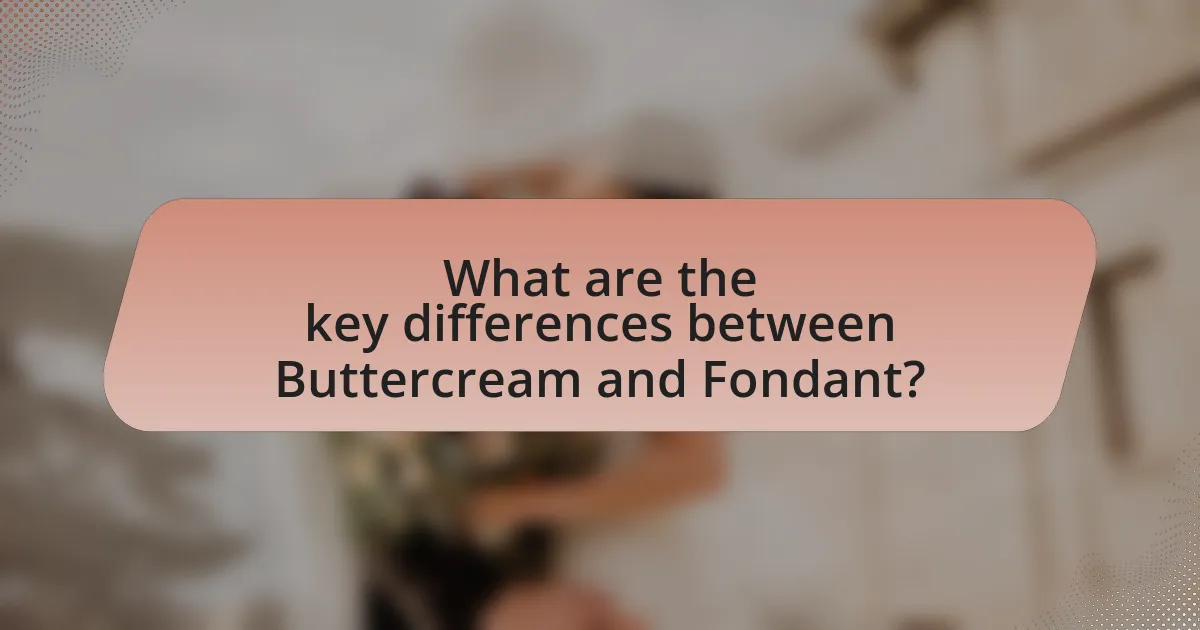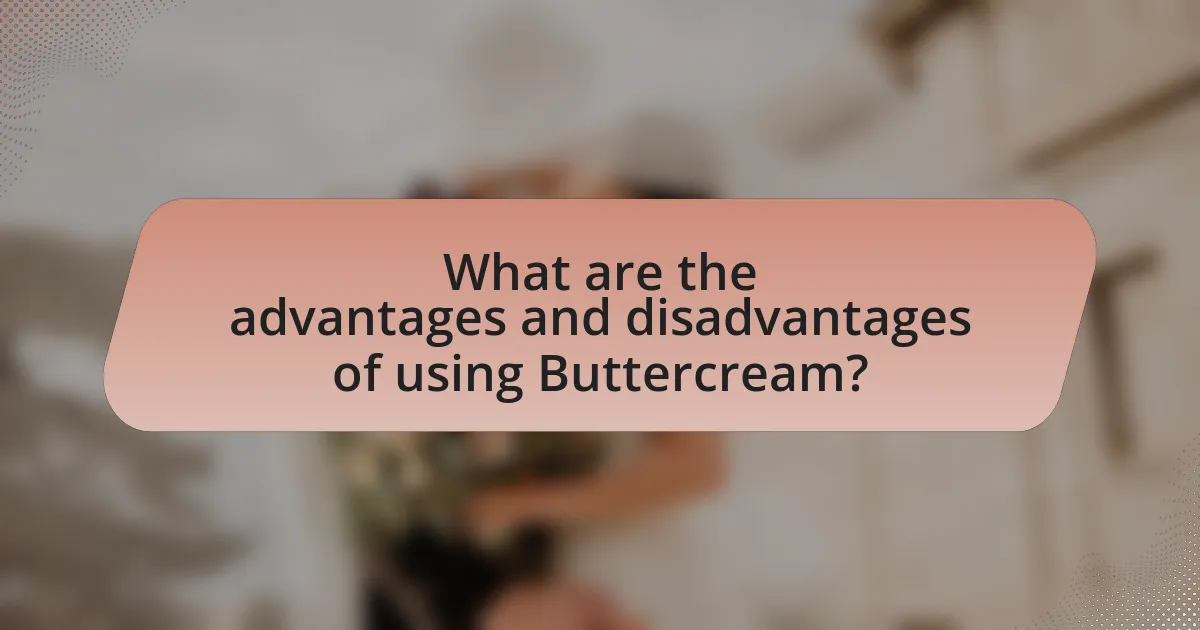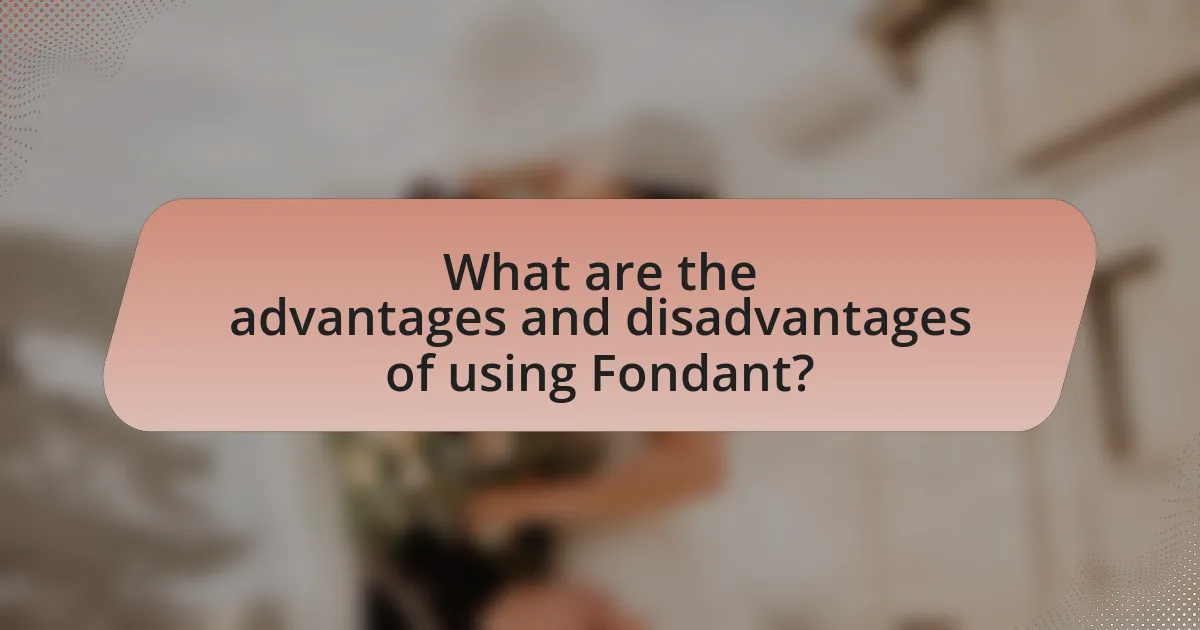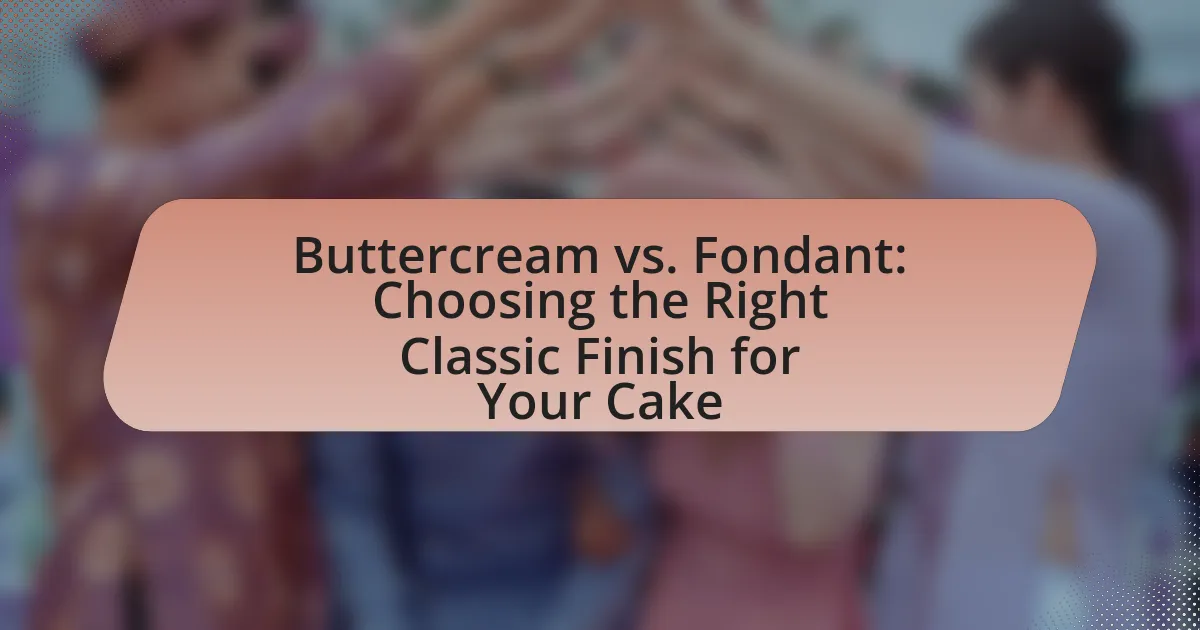The article focuses on the key differences between Buttercream and Fondant, two popular cake finishes. It outlines their distinct textures, flavors, and applications, highlighting how Buttercream is creamy and rich, ideal for frosting and filling, while Fondant offers a smooth, polished finish suitable for intricate designs. The article also discusses the factors influencing the texture of Buttercream, the advantages and disadvantages of both options, and how to choose between them based on occasion and desired aesthetics. Additionally, it explores the possibility of combining both finishes for a unique cake presentation.

What are the key differences between Buttercream and Fondant?
Buttercream is a creamy frosting made primarily from butter and sugar, while fondant is a smooth, pliable icing made from sugar, water, and gelatin. The key differences lie in texture and application; buttercream is soft and spreadable, making it ideal for frosting and filling cakes, whereas fondant provides a sleek, polished finish that can be rolled out and draped over cakes for a smooth appearance. Additionally, buttercream has a rich, buttery flavor, while fondant is often less flavorful, serving more as a decorative element than a taste enhancer.
How does the texture of Buttercream compare to Fondant?
Buttercream has a creamy and smooth texture, while fondant is firm and pliable. The softness of buttercream allows it to spread easily and create a light, fluffy finish on cakes, making it ideal for intricate designs and decorations. In contrast, fondant’s elasticity enables it to be rolled out and draped over cakes, providing a sleek and polished appearance. This difference in texture affects not only the aesthetic but also the mouthfeel; buttercream is rich and buttery, whereas fondant is more chewy and can be overly sweet for some palates.
What factors influence the texture of Buttercream?
The texture of buttercream is influenced primarily by the ratio of fat to sugar, the type of fat used, and the method of mixing. A higher fat-to-sugar ratio results in a creamier texture, while a lower ratio yields a stiffer consistency. The type of fat, such as unsalted butter or shortening, also affects the texture; butter creates a softer, more flavorful buttercream, whereas shortening produces a firmer texture. Additionally, the mixing method, including the duration and speed, can incorporate air, leading to a lighter, fluffier texture. These factors are critical in achieving the desired consistency for various cake applications.
How does Fondant achieve its smooth finish?
Fondant achieves its smooth finish through a combination of its composition and application technique. The primary ingredients in fondant, such as sugar, water, and gelatin, create a pliable and malleable texture that can be rolled out into thin sheets. When applied to a cake, the fondant is smoothed over the surface, allowing it to conform to the shape of the cake without wrinkles or seams. This process is enhanced by using tools like smoothing spatulas or fondant smoothers, which help eliminate any imperfections. The result is a sleek, polished appearance that is characteristic of fondant-covered cakes.
What flavors are commonly associated with Buttercream and Fondant?
Buttercream is commonly associated with flavors such as vanilla, chocolate, and almond, while fondant is typically linked to flavors like vanilla, chocolate, and fruit extracts. Buttercream’s rich and creamy texture enhances these flavors, making them more pronounced in cakes. Fondant, being a sugar-based icing, often has a more subtle flavor profile, which is why it is frequently flavored with vanilla or fruit extracts to complement the cake beneath.
How can flavor variations enhance Buttercream?
Flavor variations can significantly enhance Buttercream by adding depth and complexity to its taste profile. By incorporating different extracts, such as vanilla, almond, or citrus, bakers can create unique flavor combinations that complement various cake types. For instance, chocolate Buttercream can be enriched with espresso for a mocha flavor, while fruit purees can introduce natural sweetness and acidity, balancing the richness of the Buttercream. This versatility allows for customization to suit different occasions and preferences, making Buttercream a more appealing choice for a wider audience.
What are the flavor limitations of Fondant?
Fondant has significant flavor limitations primarily due to its high sugar content and the use of artificial flavorings. The predominant taste of fondant is sweet, which can overshadow other flavors in a cake. Additionally, many fondants are flavored minimally, often relying on vanilla or almond extracts, which do not provide a wide range of flavor profiles. This lack of complexity can make fondant less appealing compared to buttercream, which can incorporate various flavors like chocolate, fruit, or spices, enhancing the overall taste experience of the cake.
What are the visual differences between Buttercream and Fondant finishes?
Buttercream finishes are typically characterized by a soft, textured appearance, while fondant finishes present a smooth, sleek surface. The texture of buttercream can vary from a rustic look with visible swirls and peaks to a more polished finish, depending on the technique used. In contrast, fondant creates a uniform, glossy look that can be molded into sharp edges and intricate designs. This difference in texture and sheen is due to the ingredients; buttercream is made from butter and sugar, resulting in a creamy consistency, whereas fondant is primarily composed of sugar, water, and gelatin, which allows it to be rolled out and draped over cakes seamlessly.
How does Buttercream allow for decorative techniques?
Buttercream allows for decorative techniques due to its versatile texture and ability to hold shapes. Its creamy consistency can be easily manipulated with various tools, enabling intricate designs such as piping flowers, creating smooth finishes, and adding texture. Additionally, buttercream can be colored and flavored, enhancing its decorative potential. The stability of buttercream, particularly when chilled, supports detailed work, making it suitable for both simple and elaborate cake decorations.
What design possibilities does Fondant offer?
Fondant offers a wide range of design possibilities for cake decoration, including smooth finishes, intricate shapes, and detailed decorations. Its pliable nature allows for easy molding and sculpting, enabling cake designers to create 3D figures, flowers, and other elaborate designs that are difficult to achieve with other icing types. Additionally, fondant can be easily colored and flavored, providing versatility in both aesthetics and taste. This adaptability is supported by its use in professional cake decorating, where it is favored for its ability to hold sharp edges and maintain structural integrity, making it ideal for tiered cakes and complex designs.

What are the advantages and disadvantages of using Buttercream?
Buttercream offers several advantages and disadvantages for cake decoration. The primary advantage of buttercream is its rich flavor and creamy texture, which enhances the overall taste of cakes. Additionally, buttercream is easy to work with, allowing for smooth application and intricate designs, making it a popular choice among bakers. However, a significant disadvantage is its sensitivity to temperature; buttercream can melt in warm conditions, compromising the cake’s appearance and structure. Furthermore, buttercream can be overly sweet for some palates, which may not appeal to everyone.
Why might someone choose Buttercream over Fondant?
Someone might choose buttercream over fondant because buttercream offers a richer flavor and a creamier texture. Unlike fondant, which is primarily made of sugar and has a chewy consistency, buttercream is made from butter and sugar, providing a taste that many find more appealing. Additionally, buttercream is easier to work with for home bakers, as it requires less specialized skill and tools compared to fondant, which often needs precise rolling and shaping. The preference for buttercream is also supported by its versatility in flavoring, allowing for a variety of tastes that can enhance the overall cake experience.
What are the benefits of Buttercream in terms of taste?
Buttercream offers a rich, creamy flavor that enhances the overall taste of cakes and desserts. Its buttery sweetness complements various cake flavors, creating a harmonious balance that is often preferred over other frostings. Additionally, buttercream can be flavored with extracts, cocoa, or fruit purees, allowing for a wide range of taste profiles that cater to different preferences. This versatility in flavoring makes buttercream a popular choice for both traditional and modern cake designs, ensuring that it not only looks appealing but also delivers a delightful taste experience.
How does Buttercream’s ease of use affect cake decorating?
Buttercream’s ease of use significantly enhances cake decorating by allowing decorators to achieve smooth finishes and intricate designs with minimal effort. This versatility enables both novice and experienced bakers to create visually appealing cakes quickly, as buttercream can be easily spread, piped, and shaped. Additionally, its forgiving nature allows for corrections during the decorating process, making it a preferred choice for many. The American Cake Decorating magazine highlights that buttercream’s adaptability in texture and flavor contributes to its popularity, as it can be customized to suit various cake styles and themes.
What challenges come with using Buttercream?
Using buttercream presents several challenges, including temperature sensitivity, difficulty in achieving sharp edges, and potential for melting in warm conditions. Buttercream can become too soft and unmanageable when exposed to heat, making it challenging to work with for intricate designs. Additionally, achieving clean, sharp edges can be difficult due to its creamy texture, which may not hold its shape as well as fondant. These factors can complicate the decorating process, especially for detailed cake designs.
How does temperature affect Buttercream’s performance?
Temperature significantly affects Buttercream’s performance by influencing its texture, spreadability, and stability. At higher temperatures, Buttercream can become too soft and may lose its shape, making it difficult to pipe or spread effectively. Conversely, at lower temperatures, Buttercream firms up, allowing for better handling and decoration. For instance, Buttercream typically performs best at room temperature, around 70°F (21°C), where it maintains a creamy consistency without being overly soft or too hard. This temperature range ensures optimal performance for cake decoration and serving.
What are common issues when working with Buttercream?
Common issues when working with buttercream include its tendency to melt in warm conditions, which can lead to a loss of structure and difficulty in decorating. Additionally, buttercream can become grainy if the sugar is not properly incorporated or if the butter is too cold, resulting in an undesirable texture. Another issue is achieving the right consistency; if it is too soft, it may not hold its shape, while if it is too stiff, it can be hard to spread or pipe. These challenges are often encountered by bakers, particularly in humid environments where moisture can affect the buttercream’s stability.

What are the advantages and disadvantages of using Fondant?
Fondant offers several advantages and disadvantages in cake decoration. The primary advantage of fondant is its smooth, polished finish, which allows for intricate designs and a professional appearance. Additionally, fondant can be molded into various shapes, making it versatile for decorative elements like flowers and figurines. However, a significant disadvantage is its taste; many find fondant overly sweet and less palatable compared to buttercream. Furthermore, fondant can be challenging to work with, as it requires specific techniques for application and can dry out quickly if not handled properly.
Why is Fondant preferred for certain cake designs?
Fondant is preferred for certain cake designs because it provides a smooth, polished finish that is ideal for intricate decorations and shapes. This pliability allows cake decorators to create sharp edges and detailed designs that are difficult to achieve with buttercream. Additionally, fondant can be rolled out to a thin layer, enabling it to cover cakes seamlessly, which enhances the overall aesthetic appeal. Its versatility in color and ability to hold shapes makes it a popular choice for themed cakes and elaborate wedding designs.
How does Fondant contribute to a polished appearance?
Fondant contributes to a polished appearance by providing a smooth, even surface that enhances the overall aesthetic of cakes. This pliable icing can be rolled out and draped over cakes, effectively covering imperfections and creating a sleek finish. The glossy texture of fondant reflects light, which adds to the visual appeal, making cakes look professionally crafted. Additionally, fondant can be easily molded into decorative shapes, further enhancing the polished look of the cake.
What are the benefits of Fondant for intricate decorations?
Fondant offers several benefits for intricate decorations on cakes, primarily its smooth texture and versatility. The smooth surface of fondant allows for clean, sharp edges and detailed designs that are difficult to achieve with buttercream. Additionally, fondant can be easily molded and shaped into various forms, enabling the creation of complex decorations such as flowers, figurines, and intricate patterns. This adaptability is supported by its ability to hold its shape once set, making it ideal for elaborate cake designs. Furthermore, fondant can be colored and flavored, providing both aesthetic appeal and taste options, which enhances the overall presentation and enjoyment of the cake.
What drawbacks should be considered when using Fondant?
Fondant has several drawbacks that should be considered, including its texture, taste, and handling difficulties. The texture of fondant can be overly firm and chewy, which may not appeal to all consumers who prefer the creamy consistency of buttercream. Additionally, fondant often has a sweet flavor that can overpower the cake itself, making it less desirable for those who enjoy more subtle tastes. Handling fondant can also be challenging; it requires specific techniques for rolling and applying, and it can dry out quickly if not managed properly. These factors can impact the overall enjoyment and presentation of the cake, making fondant less favorable in certain situations.
How does the taste of Fondant compare to Buttercream?
Fondant has a more neutral, slightly sweet flavor compared to Buttercream, which is rich and creamy with a buttery taste. Fondant is primarily made from sugar, water, and gelatin, resulting in a texture that is smooth and pliable but less flavorful. In contrast, Buttercream is made with butter and sugar, providing a more pronounced and indulgent taste. This difference in flavor profiles makes Buttercream generally more favored for its taste, while Fondant is often chosen for its aesthetic appeal and ability to create smooth finishes on cakes.
What are the challenges of working with Fondant in humid conditions?
Working with fondant in humid conditions presents significant challenges, primarily due to its sensitivity to moisture. High humidity can cause fondant to become sticky and difficult to handle, leading to issues with shaping and applying it smoothly on cakes. Additionally, moisture can lead to fondant sweating, which results in unsightly water droplets on the surface and can compromise the overall appearance of the cake. This phenomenon occurs because fondant is primarily made of sugar, which absorbs moisture from the air, altering its texture and integrity. Consequently, bakers often find it necessary to adjust their techniques or use additional ingredients, such as tylose powder, to counteract the effects of humidity, ensuring better stability and workability of the fondant.
How do I choose between Buttercream and Fondant for my cake?
To choose between Buttercream and Fondant for your cake, consider the desired texture and appearance. Buttercream offers a creamy, rich flavor and a softer texture, making it ideal for traditional cakes and easy to work with for piping and decorating. In contrast, Fondant provides a smooth, polished finish that can create intricate designs and shapes, but it has a denser texture and a sweeter taste. The choice ultimately depends on whether you prioritize flavor and ease of application (Buttercream) or a sleek, professional look with more design possibilities (Fondant).
What factors should influence my decision based on the occasion?
The factors that should influence your decision based on the occasion include the type of event, the desired aesthetic, and the cake’s flavor profile. For instance, formal events like weddings often call for fondant due to its sleek appearance and ability to create intricate designs, while casual gatherings may be better suited for buttercream, which offers a more rustic and approachable look. Additionally, the flavor preferences of the guests should be considered; buttercream typically provides a richer taste that complements various cake flavors, whereas fondant can be less flavorful and may not appeal to everyone.
How can I combine both Buttercream and Fondant for a unique finish?
To combine both Buttercream and Fondant for a unique finish, first apply a smooth layer of Buttercream to the cake as a base. This layer acts as an adhesive and provides a stable surface for the Fondant. After chilling the Buttercream layer to set it, roll out the Fondant and drape it over the cake, smoothing it down to eliminate air bubbles. This technique allows for the soft texture of Buttercream to complement the sleek finish of Fondant, creating a visually appealing and texturally interesting cake. The combination enhances both flavor and aesthetics, as Buttercream adds richness while Fondant provides a polished look.
